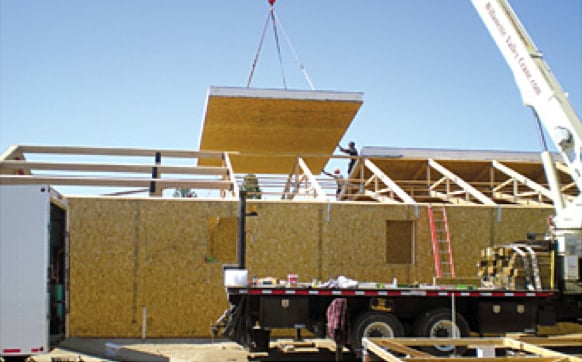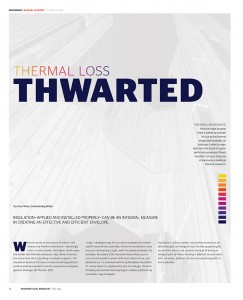Lumber Prices Are Volatile — SIPs Slash Costs and Risk
Lumber tariffs driving up costs? SIPs cut lumber use by up to 80%, lower labor needs, and deliver stronger, faster, more..
Originally printed in Architectural Products Magazine, Features Special Report, Insulation, Nov 2013
 SIPs incorporate structure and insulation into one assembly, not only providing continuous insulation but also resulting in fewer gaps to seal.
SIPs incorporate structure and insulation into one assembly, not only providing continuous insulation but also resulting in fewer gaps to seal.
When it comes to insulation, R-value- the measure of thermal resistance – seemingly rules. In other words, the higher the R-value the better the thermal resistance. But there’s more to the story than that according to industry experts. ”An insulation product’s R-value is only a starting point for understanding how well it works, says James Hodgson, general manager for Premier SIPS.
In fact, Hodgson says it’s crucial to evaluate the whole-wall R-value of the assembly, since the insulation is only one part of creating a tight, well-insulated envelope. For example, he claims DOE research shows that a 4.5-in. structural insulation panel (SIP) wall rated at R-14, out-performs a 2×6 stud wall with R-19 fiberglass insulation. ”It comes down to significantly less air leakage, thermal bridging and convective looping for a better performing assembly,” says Hodgson.
Insulation, unfortunately, is too often treated as an afterthought, as Hodgson says it ends up getting fit around the structural systems instead of being an integral part of them, making it difficult to seal leaks. SIPs, he notes, address this by incorporating both in one assembly.
 Architectural Products Magazine, Nov 2013
Architectural Products Magazine, Nov 2013
Longevity is another consideration when it comes to R-values. ”It’s common for building professionals to look at R-value per inch at the time of installation, “says Ram Mayilvahanan, product marketing manager with Insulfoam. ”Yet, it makes more sense to evaluate insulation’s long-term thermal performance and the return on investment.”
His company manufactures HD composite roof insulation, which bonds expanded polystyrene (EPS) foam to a high-density polyiso cover board, a combination that has high thermal efficiency and provides significant field labor savings. Plus, Mayilvahanan says it can be used to achieve UL Class A fire ratings on combustible roof decks without the use of gypsum or other cover boards.
“Many rigid foam insulations experience thermal drift, which is a loss of R-value over time as insulating gases within them dissipate and are replaced by air,” Mayilvahanan continues. ”Some materials lose up to 20% of their insulating capacity during their time in service.” One the other hand, EPS insulation, he explains, not only offers a high initial R-value, it also doesn’t lose R-value with time. And, it can be used in wall, roof, below-grade and under-slab applications.
Continue to read FULL article (pdf) where further insulation considerations and types are described by industry experts.
By: Alan Weis, Contributing Writer
QUESTIONS:
Lumber tariffs driving up costs? SIPs cut lumber use by up to 80%, lower labor needs, and deliver stronger, faster, more..
SIPs deliver proven energy savings. Third-party studies show 40–60% lower energy use, smaller HVAC loads, and long-term..
SIP Myths: These are the most common misconceptions our sales reps hear in the field, and we’re here to set the record..
High-performance buildings start with better systems.
Premier SIPS deliver a building envelope that outperforms traditional framing in efficiency, strength, and long-term durability. If your project demands higher performance and greater predictability, let’s talk.